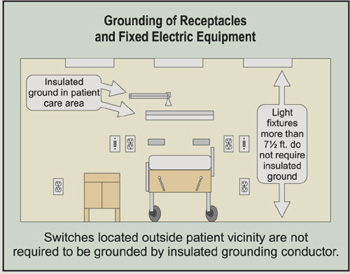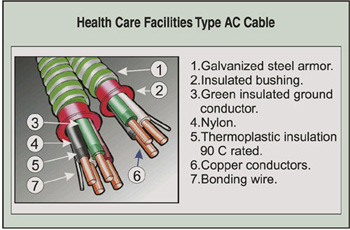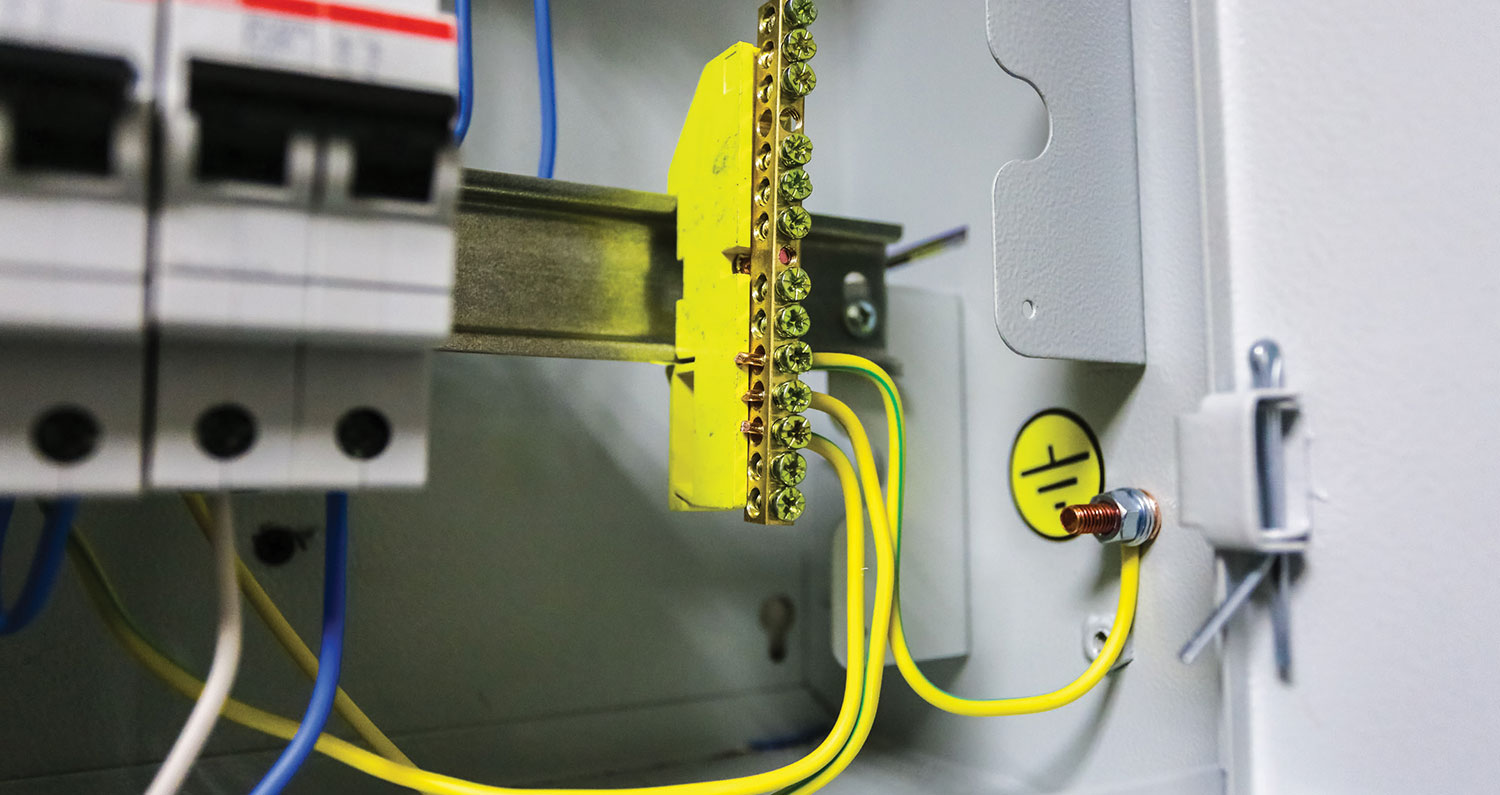The purpose of the grounding portions of Article 517 of the National Electrical Code (NEC) is to reduce low voltage potential differences between electrically conductive surfaces that may be reached by a patient or care provider in the patient vicinity. Two independent means of grounding are required for the patient care areas and are connected in parallel. This limits the voltage and, thus, the electrical currents that the patient is exposed to and will reduce or eliminate the electrical shock hazard.
The NEC defines these patient care areas:1
•Patient Care Area. Any portion of a health care facility wherein patients are intended to be examined or treated. Areas of a health care facility in which patient care is administered are classified as general care areas or critical care areas, either of which may be classified as a wet location. The governing body of the facility designates these areas in accordance with the type of patient care anticipated and with the following definitions of the area classification.
FPN.Business offices, corridors, lounges, day rooms, dining rooms, or similar areas typically are not classified as patient care areas.
a. General Care Areas. General care areas are patient bedrooms, examining rooms, treatment rooms, clinics, and similar areas in which it is intended that the patient shall come in contact with ordinary appliances such as a nurse call system, electrical beds, examining lamps, telephone, and entertainment devices. In such areas, it may also be intended that patients be connected to electromedical devices (such as heating pads, electrocardiographs, drainage pumps, monitors, ostoscopes, ophthalmoscopes, intravenous lines, etc.).
b. Critical Care Areas. Critical care areas are those special care units, intensive care units, coronary care units, angiography laboratories, cardiac catheterization laboratories, delivery rooms, operating rooms, and similar areas in which patients are intended to be subjected to invasive procedures and connected to line-operated, electromedical devices.
•Patient Equipment Grounding Point (PEGP). A jack or terminal bus that serves as the collection point for redundant grounding of electric appliances serving a patient vicinity or for grounding other items in order to eliminate electromagnetic interference problems.
•Patient Vicinity. In an area in which patients are normally cared for, the patient vicinity is the space with surfaces likely to be contacted by the patient or an attendant who can touch the patient. Typically in a patient room, this encloses a space within the room not less than 6 ft (1.83 m) beyond the perimeter of the bed in its nominal location, and extending vertically not less than 7 ½ ft (2.29 m) above the floor.
•Reference Grounding Point. The ground bus of the panelboard or isolated power system panel supplying the patient care area.

Figure 1. Type MC, AC & MI cable must have a metallic outer covering that is identified as acceptable for grounding.
All branch circuits serving the patient care area must be installed in a metallic raceway system or cable assembly. A metallic raceway system used for equipment grounding must comply with the requirements of Section 250-1181. Type MC, AC & MI cable must have a metallic outer covering that is identified as acceptable for grounding. (See Figure 1)
All grounding terminals of all receptacles and all non-current carrying electrically conductive surfaces of fixed electric equipment in the patient care area, operating at more than 100 volts, must be grounded using an insulated copper conductor. This grounding conductor must be sized per Section 250-1221, Table 250-122 and installed in the branch circuit metallic raceway or identified cable assembly. (See Figure 2)

Figure 2. This grounding conductor must be sized per Section 250-1221, Table 250-122 and installed in the branch circuit metallic raceway or identified cable assembly.
Metal faceplates can be grounded by means of a metal mounting screw(s) securing the faceplate to a grounded outlet box or grounded wiring device.
Light fixtures more than 7½ ft above the floor and switches located outside of the patient vicinity shall not be required to be grounded by an insulated grounding conductor.
Patient bed location receptacles must be listed as hospital grade and grounded to the reference grounding point using an insulated copper equipment grounding conductor sized per Section 250-1221, Table 250-122.

Figure 3. An equipment bonding jumper No. 10 or larger must be used to bond the PEGP to the grounding terminal of all grounding type receptacles
A patient equipment grounding point (PEGP) is permitted in critical care areas and must be furnished with listed connectors. An equipment bonding jumper No. 10 or larger must be used to bond the PEGP to the grounding terminal of all grounding type receptacles. (See Figure 3)
A grounded electrical system feeder that is used to feed a panelboard for critical care area branch circuits must have the metal feeder raceway or type MC or MI cable grounded at each termination or junction point as follows1:
1. A grounding bushing and a continuous copper bonding jumper, sized in accordance with Section 250-1221, with the bonding jumper connected to the junction enclosure or the ground bus of the panel
2. Connection of feeder raceways or Type MC or MI cable to threaded hubs or bosses on terminating enclosures
3. Other approved devices such as bonding-type locknuts or bushings
Summary
Grounding of health care facilities is both complex and essential. Only the patient care area grounding has been discussed in this article to help provide insight and a better understanding of the basic requirements. Inspection of these systems requires detailed knowledge of the plans, specifications and NEC requirements.
1 NFPA 70 National Electrical Code 1999 Edition










Find Us on Socials